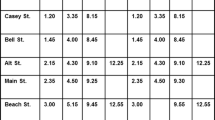Abstract
This study in the domain of statistics comparesfour information presentation formats in a 2 × 2factorial design: timing of supportiveinformation (before or during taskpractice) × timing of procedural information(before or during task practice).Seventy-two psychology and education students(7 male and 65 female; mean age 18.5 years,SD = 2.85) participated. Theeffectiveness of the learning material wasmeasured by test performance. The instructionalefficiency was measured by a combination ofmental effort during practice and testperformance (i.e., a high test performancecombined with a low mental effort duringpractice denotes a high instructionalefficiency). ANOVA showed a main effect fortiming of supportive information: presentationduring practice led to more efficient learning than presentationbefore practice. Moreover, an interactioneffect was found. Simultaneous presentation ofprocedural information before andsupportive information during practiceled to the most efficient learning.
Similar content being viewed by others
References
Anderson, J.R. (1993) Rules of the Mind. Hillsdale, NJ: Lawrence Erlbaum.
Anderson, J.R. (1996) ACT: A simple theory of complex cognition. American Psychologist 51: 355–365.
Ausubel, D.P. (1963) The Psychology of Meaningful Verbal Learning. New York: Grune & Stratton.
Ausubel, D.P. & Robinson, F.G. (1969) School Learning: An Introduction to Educational Psychology. London: Holt, Rinehart & Winston.
Baddeley, A.D. (1992) Working memory. Science 255: 556–559.
Carlson, R.A., Sullivan, M.A. & Schneider, W. (1989) Component fluency in a problem solving context. Human Factors 31(5): 489–502.
Carlson, R.A., Khoo, B.H. & Elliott II, R.G. (1990) Component practice and exposure to a problem-solving context. Human Factors 32(3): 267–286.
Cerpa, N., Chandler, P. & Sweller, J. (1996) Some conditions under which integrated computer-based training software can facilitate learning. Journal of Educational Computing Research 15(4): 345–367.
Chandler, P. & Sweller, J. (1991) Cognitive load theory and the format of instruction. Cognition and Instruction 8(4): 293–332.
Chandler, P. & Sweller, J. (1992) The split attention effect as a factor in the design of instruction. British Journal of Educational Psychology 62: 233–246.
Chandler, P. & Sweller, J. (1996) Cognitive load while learning to use a computer program. Applied Cognitive Psychology 10: 151–170.
Derry, S. & Lesgold, A. (1996) Toward a situated social practice model for instructional design. In David C. Berliner & Robert C. Calfee (eds), Handbook of Educational Psychology, pp. 787–806. New York, London et al.: Macmillan; Simon & Schuster.
Fisk, A.D. & Gallini, J.K. (1989) Training consistent components of tasks: Developing an instructional system based on automatic-controlled processing principles. Human Factors 31: 453–463.
Johnson, R.E. (1975) Meaning in complex learning. Review of Educational Research 45(3): 425–454.
Kalyuga, S., Chandler, P. & Sweller, J. (1999) Managing split-attention and redundancy in multimedia instruction. Applied Cognitive Psychology 13(4): 351–371.
Kester, L., Kirschner, P.A., Van Merriënboer, J.J.G. & Bäumer, A. (2001) Just-in-time information presentation and the acquisition of complex cognitive skills. Computers in Human Behavior 17: 373–391.
Koschman, T.D., Myers A.C., Feltovich, P.J. & Barrows, H.S. (1994) Using technology to assist in realizing effective learning and instruction: A principled approach to the use of computers in collaborative learning. Journal of the Learning Sciences 3(3): 227–264.
Mayer, R.E. (1979) Can advance organizers influence meaningful learning? Review of Educational Research 49: 371–383.
Mayer, R.E. & Anderson, R.B. (1991) Animations need narrations: An experimental test of a dual-coding hypothesis. Journal of Educational Psychology 83: 484–490.
Mayer, R.E. & Anderson, R.B. (1992) The instructive animation: Helping students build connections between words and pictures in multimedia learning. Journal of Educational Psychology 84(4): 444–452.
Mayer, R.E. & Moreno, R. (1998) Split-attention effect in multimedia learning: Evidence for dual processing systems in working memory. Journal of Educational Psychology 90(2): 312–320.
Mayer, R.E. & Sims, V.K. (1994) For whom is a picture worth a thousand words? Extensions of a dual-coding theory of multimedia learning. Journal of Educational Psychology 86(3): 389–401.
Miller, G.A. (1956) The magical number seven plus or minus two: Some limits on our capacity for processing information. Psychological Review 63: 81–97.
Novak, J.D. (1984) Application of advances in learning theory and philosophy of science to the improvement of chemistry teaching. Journal of Chemical Education 61(7): 607–612.
Novak, J.D. & Gowin, D.B. (1984) Learning How to Learn. Cambridge: Cambridge University Press.
Paas, F. (1992) Training strategies for attaining transfer of problem-solving skill in statistics: A cognitive-load approach. Journal of Educational Psychology 84(4): 429–434.
Paas, F. & Van Merriënboer, J.J.G. (1993) The efficiency of instructional conditions: An approach to combine mental effort and performance measures. Human Factors 35(4): 737–743.
Paas, F., Van Merriënboer, J.J.G. & Adam, J.J. (1994) Measurement of cognitive load in instructional research. Perceptual and Motor Skills 79: 419–430.
Proctor, R.W. & Reeve, T.G. (1988) The acquisition of procedural productions and modification of declarative representations in spatial precueing tasks. Journal of Experimental Psychology: General 117: 293–307.
Salomon, G. & Perkins, D.N. (1998) Individual and social aspects of learning. Review of Research in Education 23: 1–24.
Sweller, J. (1988) Cognitive load during problem solving: Effects on learning. Cognitive Science 12: 257–285.
Sweller, J. (1999) Instructional Design in Technical Areas. Camberwell, Australia: ACER Press.
Sweller, J. & Chandler, P. (1994) Why some material is difficult to learn. Cognition and Instruction 12(3): 185–233.
Sweller, J., Van Merriënboer, J.J.G. & Paas, F. (1998) Cognitive architecture and instructional design. Educational Psychology Review 10(3): 251–296.
Valcke, M.P., Kirschner, P.A. & Bos, E. (1999) Enabling technologies to design, produce, and exploit flexible, electronic learning materials. In: J. van den Akker, R.M. Branch, K. Gustafson, N. Nieveen & Tj Plomp (eds), Design Approaches and Tools in Education and Training. Dordrecht: Kluwer.
Van Merriënboer, J.J.G., Kirschner, P.A. & Kester, L. (2003) Taking the load of a learner's mind. Instructional design for complex learning. Educational Psychologist 38(1): 5–13.
Williams, K.A. & Cavallo, A.M. (1995) Relationships between reasoning ability, meaningful learning and students' understanding of physics concepts. Journal of College Science Teaching 24(5): 311–314.
Author information
Authors and Affiliations
Rights and permissions
About this article
Cite this article
Kester, L., Kirschner, P.A. & van Merriënboer, J.J. Timing of Information Presentation in Learning Statistics. Instructional Science 32, 233–252 (2004). https://doi.org/10.1023/B:TRUC.0000024191.27560.e3
Issue Date:
DOI: https://doi.org/10.1023/B:TRUC.0000024191.27560.e3




